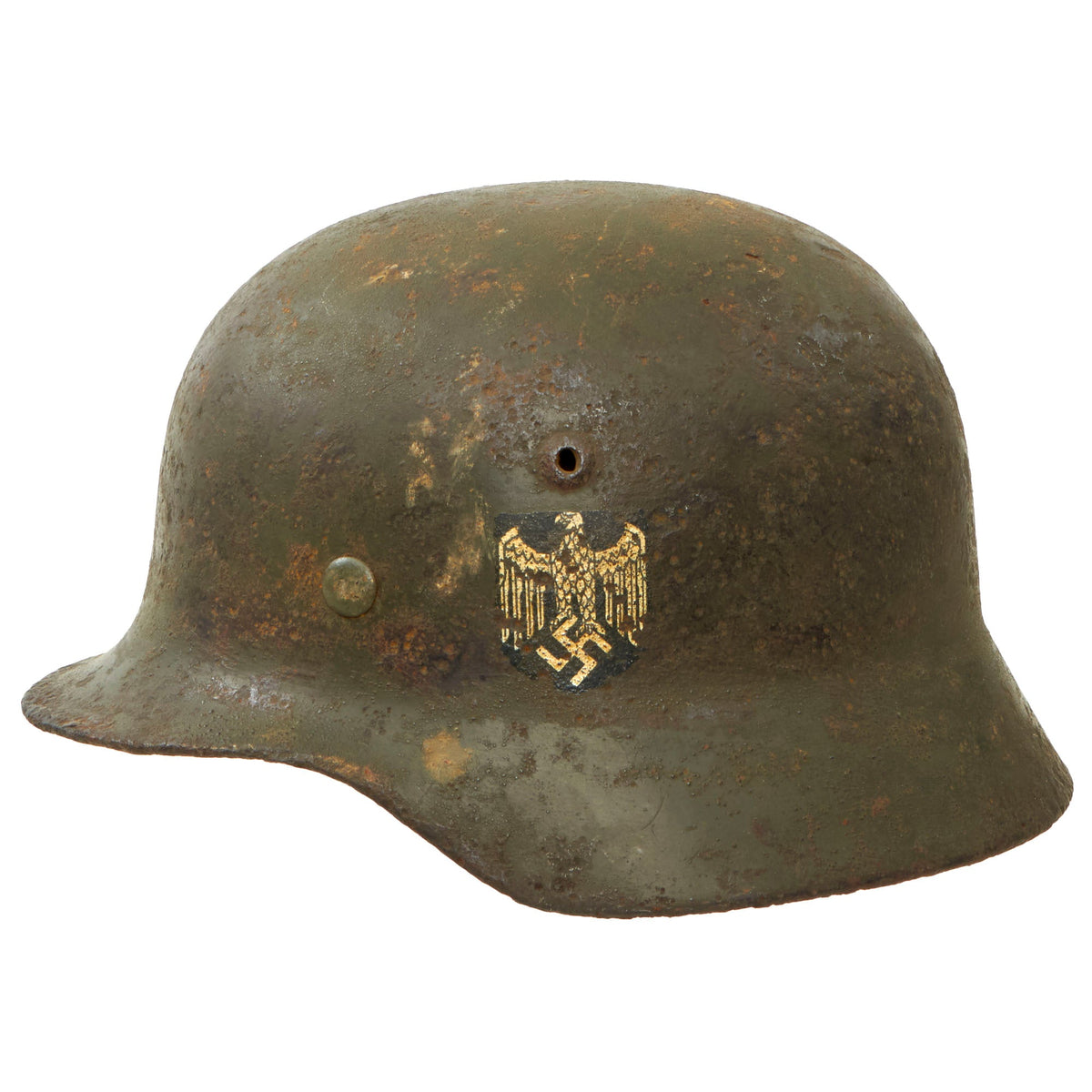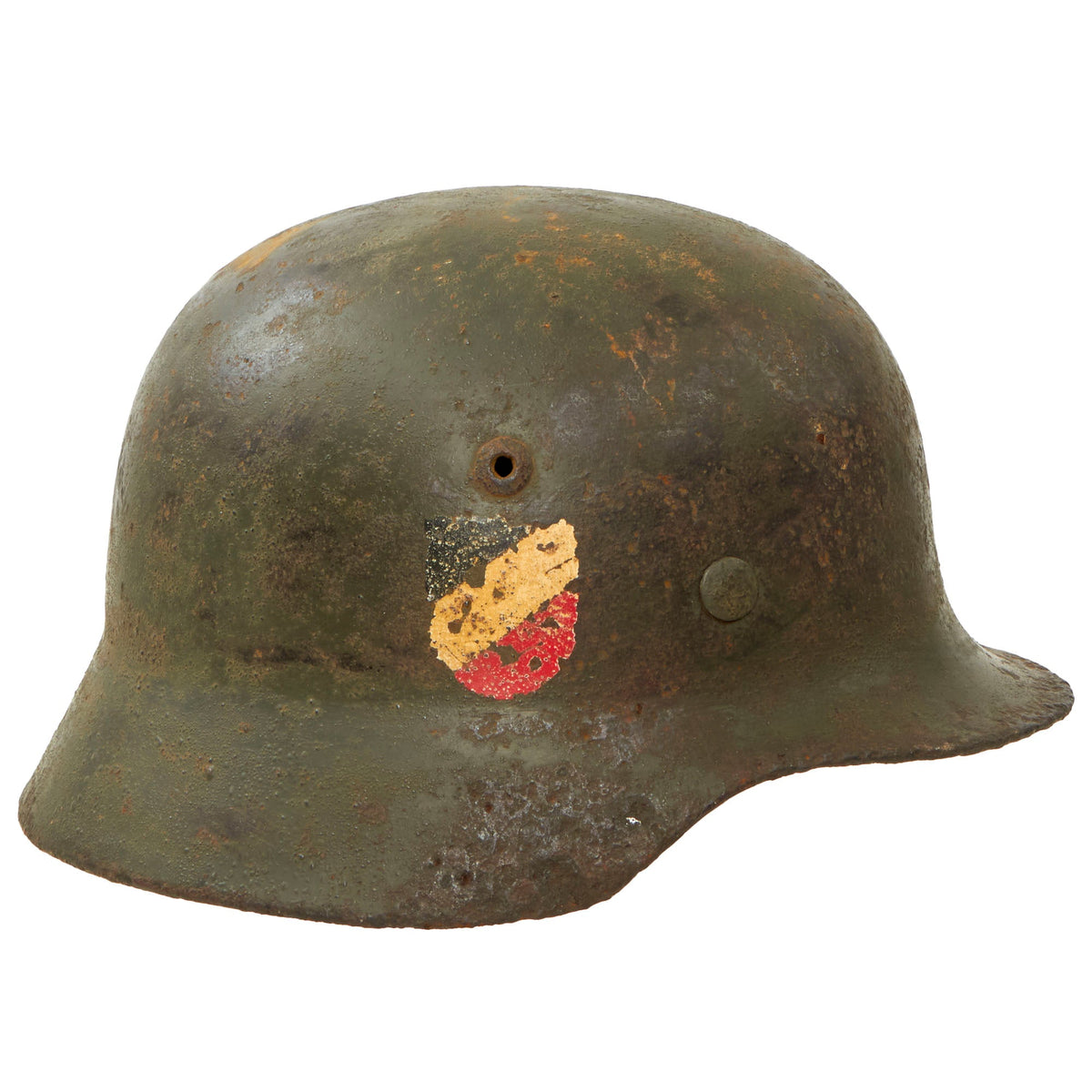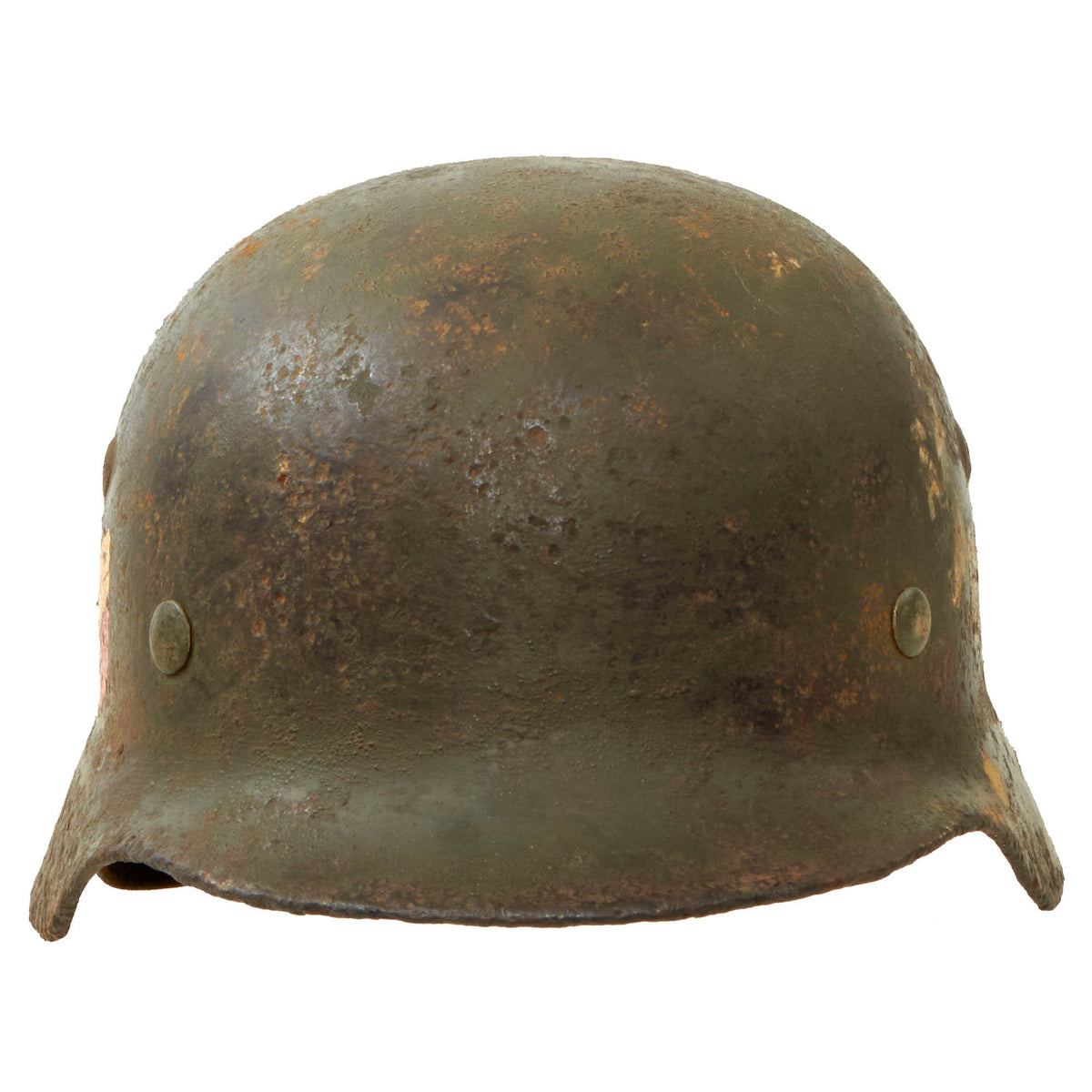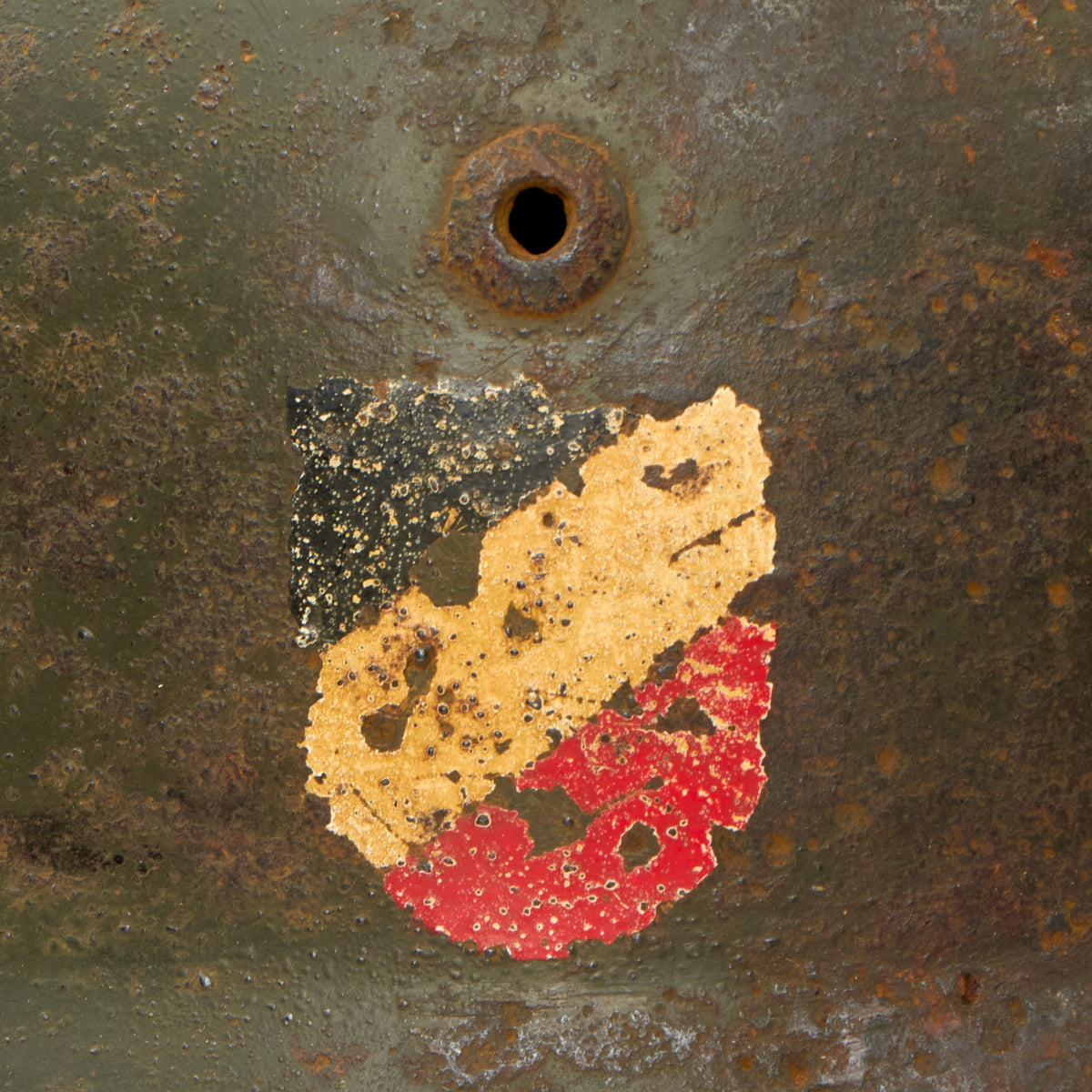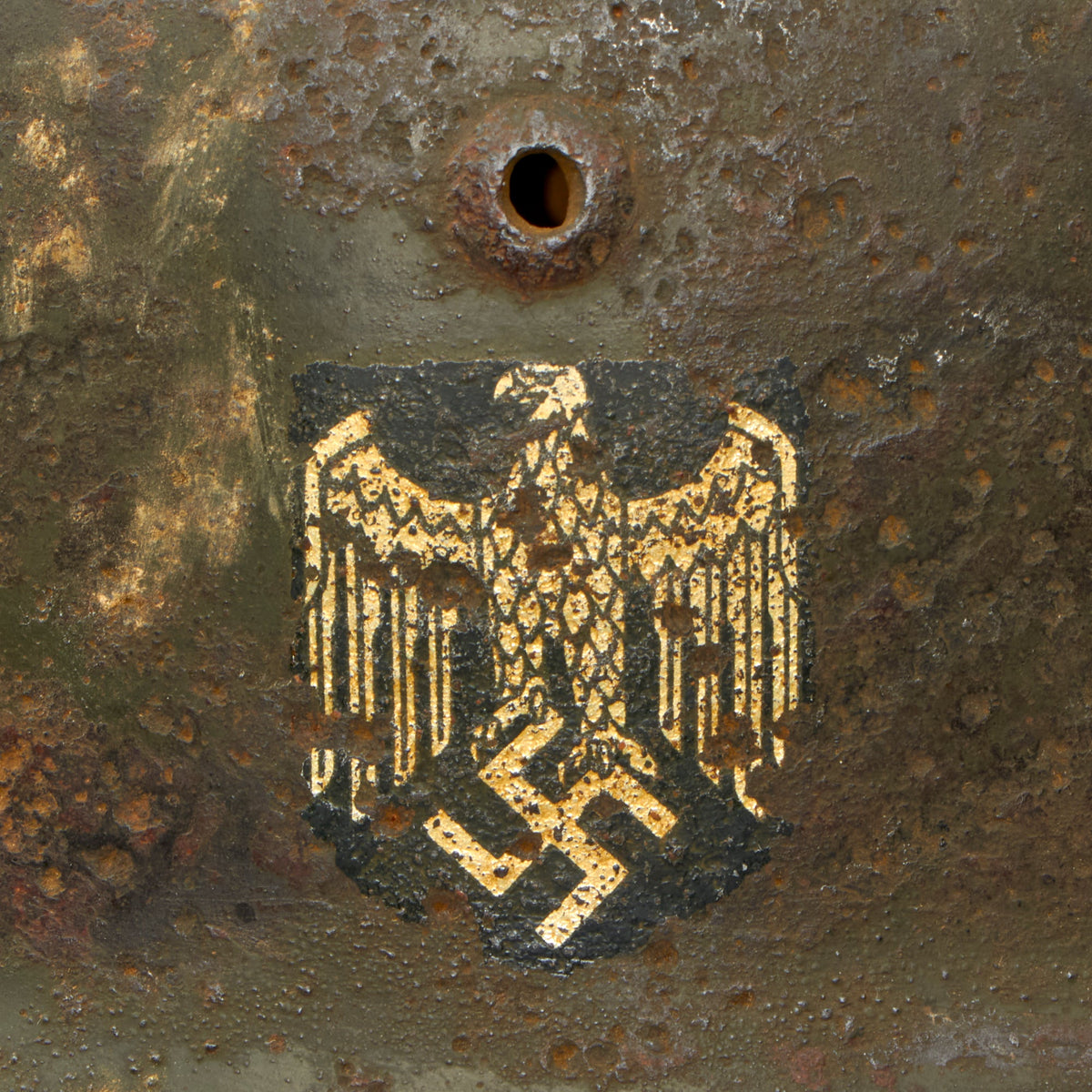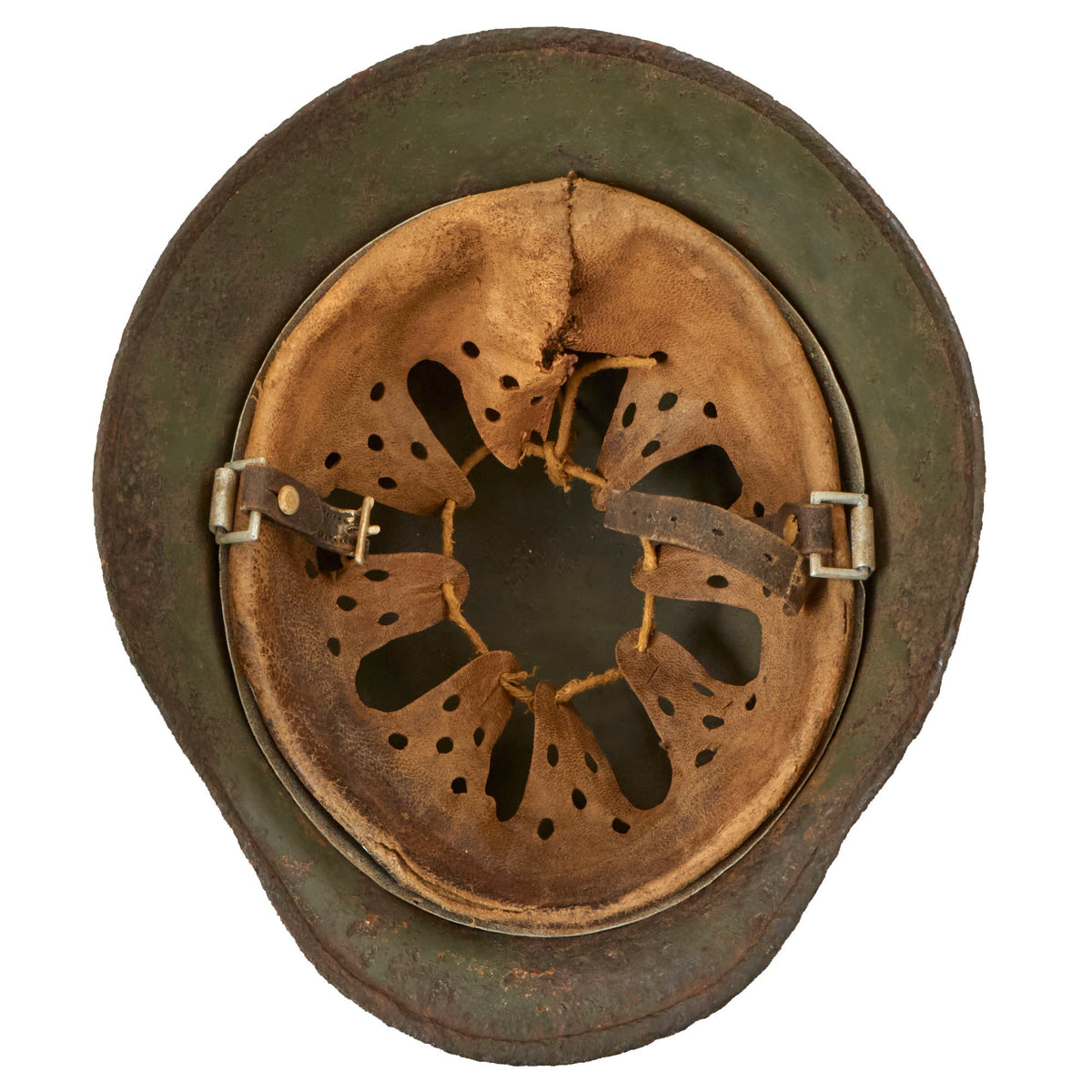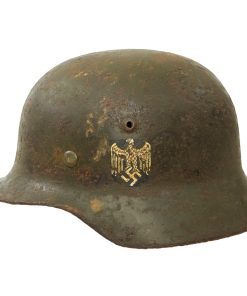Original German WWII Ground Dug Army Heer M35 Double Decal Helmet Shell with Liner & Chinstrap – Size 60cm Shell Original Items
$ 795,00 $ 238,50
Original Item: Only One Available. This is a great “ground dug” example of a German WWII M35 helmet, as issued to the Heer (Army), with very desirable “Double Decals” and some other interesting features. This stamped sheet steel construction helmet was originally produced with early war smooth Apfel-grün (apple green) paint, and then fitted with Heer “Double Decals”, a Heer (army) eagle over the left ear, and the German Tri-color “National Colors” decal, over the right ear.
At some point after that, it was dropped on the ground, or possibly lost in a fox hole, and was left to the elements for some time, possibly covered with dirt. In spite of this, it still retains a lot of the original paint on the interior and exterior, interspersed with areas where it eroded while lying in the field or under ground, allowing rust pitting to occur. This is particularly evident on the interior skirt and on the exterior rear “dome”. The leather and felt portions of the liner, as well as the chinstrap, would have completely rotted away.
After the helmet was found, the original aluminum liner band was still present, attached with the original WWII pattern split pins. We believe that it was then was fitted with a replacement original interior section with attached leather, and a correct early pattern chinstrap attached as well.
The use of the second decal was discontinued in 1940, and in 1943 it was ordered that helmets with the national colors have them removed, so finding a helmet with both still intact is a real treasure, even with the oxidation issues. Most likely the helmet was lost before that point, so the decals were never removed. They are both retained at about 75%, with the expected wear and bubbling from being buried for years.
The reverse, interior, neck guard apron is lot number stamped E 158, however the interior, left side, apron has pit rusting, which has obliterated the manufacturers code and size. We did some research regarding lot numbers, and the “E” prefix was only used by one maker: Vereinigte Deutsche Nikelwerke, of Schwerte, Germany, so this helmet was almost certainly originally marked “NS60” on the left apron. Without any size marking, we measured the exterior of the helmet around the liner split pins, and it measures out at 61cm, making it a 60cm size, the smallest size made during the war. This is an extra small size that can accommodate liners from 52cm to 53cm or US 6 1/2 to 6 3/8. Shells this small are extremely rare, and we have only had a handful, even when compared to the extra large size 68.
All three of the original liner split pins are present, and actually still retain a good amount of the original paint. The interior of the helmet still has the original M31 leather liner with all eight of its fingers intact, though the top securing strap is a replacement. The leather is still relatively supple, but definitely shows that it saw a good amount of service, so it was definitely chosen to match the condition of the shell. The liner band is aluminum and of the earliest pattern, with square aluminum chin strap loops attached without any side reinforcements. Later Pre-war examples would have a double layer of aluminum on the side to prevent bending. The left exterior of the liner band is marked 62 n.A / 55, indicating that it is a size 55 liner for a size 62 shell.
This is not the right size liner for this shell, however it definitely is still fitted inside of the shell, even though it shouldn’t be able to fit. The split pins do not show any signs of being messed with, so we can only conclude that a liner was modified to fit this very small size when it was at the factory. The right side displays the full manufacture information, as well as a date:
D. R. P.
SCHUBERTH-WERK
G.m.b.H.
BRAUNSCHWEIG
This is the earliest pattern marking from Schuberth-Werk, which may have had a date under it, however it was stamped too lightly to read.
The helmet still has a chinstrap attached, but it is definitely in well used condition, and now quite stiff. It has the correct aluminum studs and hardware, however the stitching around the buckle has completely rotted out. The longer section has lost some length, and only has 7 of the original 13 size adjustment holes. The leather on both sides is in very delicate condition.
Overall a very nice 100% genuine M35 Double Decal Heer Army “ground dug” helmet shell with loads of history and a complete liner with partial chinstrap! This is an item that will only continue to appreciate in value over time!
The first “modern” steel helmets were introduced by the French army in early 1915 and were shortly followed by the British army later that year. With plans on the drawing board, experimental helmets in the field, (“Gaede” helmet), and some captured French and British helmets the German army began tests for their own steel helmet at the Kummersdorf Proving Grounds in November, and in the field in December 1915. An acceptable pattern was developed and approved and production began at Eisen-und Hüttenwerke, AG Thale/Harz, (Iron and Foundry Works), in the spring of 1916.
These first modern M16 helmets evolved into the M18 helmets by the end of WWI. The M16 and M18 helmets remained in usage through-out the Weimar Reichswehr, (National Defence Force, Circa 1919-1933), era and on into the early years of the Third Reich until the development of the smaller, lighter M35 style helmet in June 1935.
In 1934 tests began on an improved Stahlhelm, whose design was a development of World War I models. The Eisenhüttenwerke company of Thale carried out prototype design and testing, with Dr. Friedrich Schwerd once again taking a hand.
The new helmet was pressed from sheets of molybdenum steel in several stages. The size of the flared visor and skirt was reduced, and the large projecting lugs for the obsolete armor shield were eliminated. The ventilator holes were retained, but were set in smaller hollow rivets mounted to the helmet’s shell. The edges of the shell were rolled over, creating a smooth edge along the helmet. Finally, a completely new leather suspension, or liner, was incorporated that greatly improved the helmet’s safety, adjustability, and comfort for each wearer. These improvements made the new M1935 helmet lighter, more compact, and more comfortable to wear than the previous designs.
The Army’s Supreme Command officially accepted the new helmet on June 25, 1935 and it was intended to replace all other helmets in service.
More than 1 million M1935 helmets were manufactured in the first two years after its introduction, and millions more were produced until 1940 when the basic design and production methods were changed.
Fast Shipping with Professional Packaging
Thanks to our longstanding association with UPS FedEx DHL, and other major international carriers, we are able to provide a range of shipping options. Our warehouse staff is expertly trained and will wrap your products according to our exact and precise specifications. Prior to shipping, your goods will be thoroughly examined and securely secured. We ship to thousands clients each day across multiple countries. This shows how we're dedicated to be the largest retailer on the internet. Warehouses and distribution centres can be located throughout Europe as well as the USA.
Note: Orders with more than one item will be assigned a processing date depending on the item.
Before shipping before shipping, we'll conduct a thorough inspection of the items you have ordered. Today, the majority of orders will be delivered within 48 hours. The delivery time will be between 3-7 days.
Returns
The stock is dynamic and we cannot completely manage it because multiple stakeholders are involved, including our factory and warehouse. So the actual stock may alter at any time. It's possible that you may not receive your order once the order has been made.
Our policy is valid for a period of 30 days. If you don't receive the product within 30 days, we are not able to issue a refund or an exchange.
You can only return an item if it is unused and in the same state as the day you received it. You must have the item in its original packaging.
Related products
Uncategorized
Uncategorized
Uncategorized
Armored Burgonet Helmet & Polearm from Scottish Castle Leith Hall Circa 1700 Original Items
Uncategorized
Australian WWII Owen MK1 Machine Carbine SMG Custom Fabricated Replica with Sling Original Items
Uncategorized
Uncategorized
Uncategorized
Uncategorized
Uncategorized
Uncategorized
Band of Brothers ORIGINAL GERMAN WWII Le. F.H. 18 10.5cm ARTILLERY PIECE Original Items
Uncategorized
Uncategorized
Uncategorized
Uncategorized
Uncategorized
Uncategorized
Uncategorized
Uncategorized
